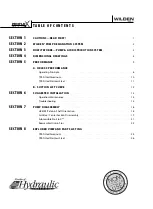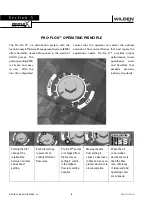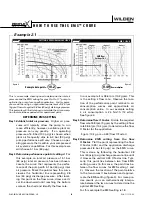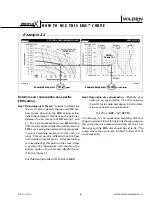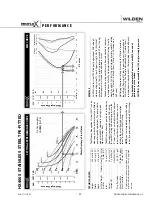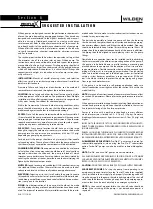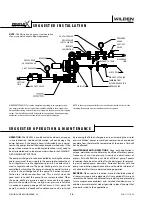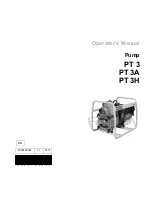
WILDEN PUMP & ENGINEERING, LLC
14
WIL-11111-E-03
S U G G E S T E D I N S T A L L A T I O N
OPERATION:
The HX400S is pre-lubricated, and does not require
in-line lubrication. Additional lubrication will not damage the
pump: however, if the pump is heavily lubricated by an external
source, the pump’s internal lubrication may be washed away. If the
pump is then moved to a non-lubricated location, it may need to
be disassembled and re-lubricated as described in the ASSEMBLY/
DISASSEMBLY INSTRUCTIONS.
The pump discharge rate can be controlled by limiting the volume
and/or pressure of the air supply to the pump (preferred method).
An air regulator is used to regulate air pressure. A needle valve is
used to regulate volume. The pump discharge rate can also be
controlled by throttling the pump discharge by partially closing
a valve in the discharge line of the pump. This action increases
friction loss, which reduces flow rate. This is useful when the
need exists to control the pump from a remote location. When
the pump discharge pressure equals or exceeds the air-supply
pressure, the pump will stop; no bypass or pressure relief valve
is needed and pump damage will not occur. At this point, the
pump has reached a “deadhead” condition and can be restarted
by reducing the fluid discharge pressure or increasing the air inlet
pressure. Wilden® pumps run solely on compressed air and do not
generate heat, therefore the temperature of the process fluid will
not be affected.
MAINTENANCE AND INSPECTIONS:
Since each application is
unique, maintenance schedules may be different for every pump.
Frequency of use, line pressure, viscosity and abrasiveness of
process fluid all affect the parts life of a Wilden® pump. Periodic
inspections have been found to offer the best means for prevent-
ing unscheduled pump downtime. Personnel familiar with the
pump’s construction, operation and service should be informed of
any abnormalities that are detected during operation.
RECORDS:
When service is required, a record should be made of
all necessary repairs and replacements. Over a period of time, such
records can become a valuable tool for predicting and preventing
future maintenance problems and unscheduled downtime. In
addition, accurate records make it possible to identify pumps that
are poorly suited to their applications.
S U G G E S T E D O P E R A T I O N & M A I N T E N A N C E
AIR-OPERATED PUMPS: To stop the pump from operating in an emergency situa-
tion, simply close the shut-off valve (user supplied) installed in the air supply line.
A properly functioning valve will stop the air supply to the pump, therefore stopping
output. This shut-off valve should be located far enough away from the pumping
equipment so that it can be reached safely in an emergency situation.
NOTE: In the event of a power failure, the shut-off valve should be closed, if the
restarting of the pump is not desirable once power is regained.
AIR INLET
PRESSURE
GAUGE
AIR SUPPLY
RETURN TO TANK
RELIEF VALVE
(SET TO 250 PSI)
DISCHARGE
LINE
SHUT-OFF VALVE
SHUT-OFF VALVE
SHUT-OFF VALVE
PRESSURE OR
VACUUM GAUGE
SUCTION
LINE
FLEXIBLE
CONNECTION
SHUT-OFF
VALVE
AIR SHUT-OFF VALVE
COMBINATION
FILTER & REGULATOR
NEEDLE VALVE
MUFFLER
NOTE:
This illustration is a generic representation
of an air-operated double-diaphragm pump.
Содержание HX400S
Страница 25: ...N O T E S ...
Страница 30: ...N O T E S ...

